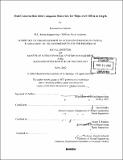| dc.contributor.advisor | David Burke and Henry S. Marcus. | en_US |
| dc.contributor.author | Galanis, Konstantinos, 1970- | en_US |
| dc.contributor.other | Massachusetts Institute of Technology. Dept. of Ocean Engineering. | en_US |
| dc.date.accessioned | 2005-09-26T19:23:41Z | |
| dc.date.available | 2005-09-26T19:23:41Z | |
| dc.date.copyright | 2002 | en_US |
| dc.date.issued | 2002 | en_US |
| dc.identifier.uri | http://hdl.handle.net/1721.1/28255 | |
| dc.description | Thesis (Nav.E. and S.M. in Ocean Systems Management)--Massachusetts Institute of Technology, Dept. of Ocean Engineering, 2002. | en_US |
| dc.description | Includes bibliographical references (leaves 124-132). | en_US |
| dc.description.abstract | The operational envelope of the maritime industry requires high performance marine vessels, which demand increased structural integrity and durability, coupled with significant weight reduction and minimization of cost. The design and fabrication of a "large vessel" by use of composite materials is within the current technology. However, a number of major technical and economic aspects are questionable. This study will examine the structural design for vessels longer than 100 m. It will also identify the major advantages and disadvantages of this composite structure compared with one made of steel, focusing on the technical and economic aspects. Material selection, fabrication methods and design concepts for composite structures, such as elimination of frames, will be explored and comparisons will be developed. The potential to significantly reduce or even eliminate the risk areas will be evaluated. Four different structural designs of a hull from composite materials are examined for a midship section of an existing naval ship (DDG51 type) and they are compared to the one built from steel. In order to select the best option of these structural designs, three variants are analyzed: structural configuration of composites, material option and fabrication process. Additionally, the effect of several critical areas, such as safety factors selection, present and future structural limitations, required fabrication experience, durability, complexity, infrastructure issues, and a cost and market analysis of using fiber reinforced plastic (FRP) in ship design and construction are included in this study. The proposed hull design combined with the optimum materials and fabrication method shows that a large ship is both technically and economically feasible. | en_US |
| dc.description.statementofresponsibility | by Konstantinos Galanis. | en_US |
| dc.format.extent | 142 leaves | en_US |
| dc.format.extent | 7837038 bytes | |
| dc.format.extent | 7856147 bytes | |
| dc.format.mimetype | application/pdf | |
| dc.format.mimetype | application/pdf | |
| dc.language.iso | en_US | |
| dc.publisher | Massachusetts Institute of Technology | en_US |
| dc.rights | M.I.T. theses are protected by copyright. They may be viewed from this source for any purpose, but reproduction or distribution in any format is prohibited without written permission. See provided URL for inquiries about permission. | en_US |
| dc.rights.uri | http://dspace.mit.edu/handle/1721.1/7582 | |
| dc.subject | Ocean Engineering. | en_US |
| dc.title | Hull construction with composite materials for ships over 100 m in length | en_US |
| dc.type | Thesis | en_US |
| dc.description.degree | Nav.E.and S.M.in Ocean Systems Management | en_US |
| dc.contributor.department | Massachusetts Institute of Technology. Department of Ocean Engineering | |
| dc.identifier.oclc | 51741146 | en_US |
